Lewin Benjamin (ed.) Genes IX
Подождите немного. Документ загружается.

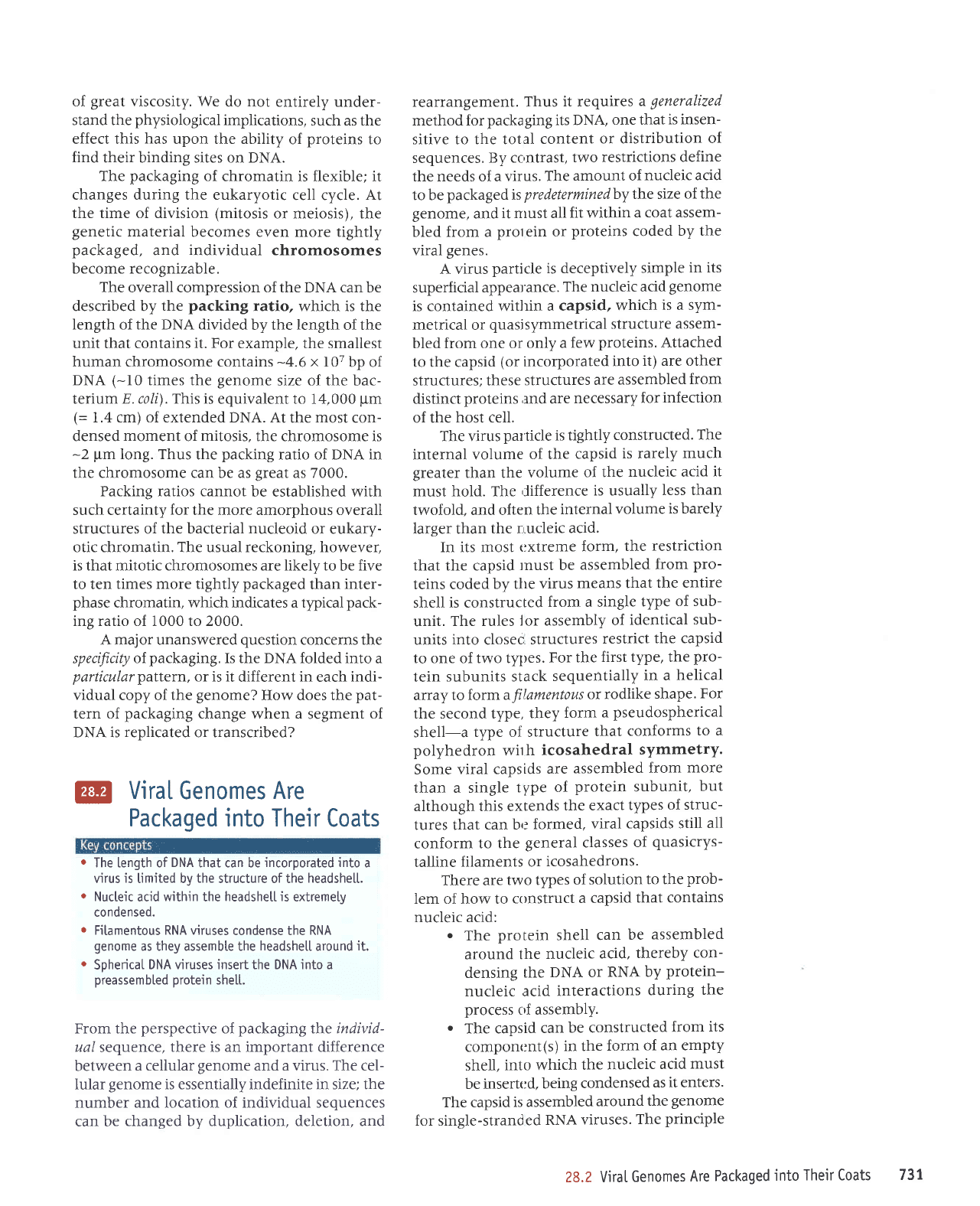
of
great
viscosity. We
do not entirely under-
stand the
physiological
implications,
such as the
effect this
has
upon the ability
of
proteins
to
find
their binding sites on DNA.
The
packaging
of
chromatin is flexible; it
changes during the eukaryotic
cell cycle.
At
the time of division
(mitosis
or meiosis), the
genetic
material
becomes even more tightly
packaged,
and
individual
chromosomes
become recognizable.
The overall compression of the DNA can
be
described by
the
packing
ratio, which is the
Iength of the DNA divided
by the length of the
unit that contains it. For example, the smallest
human chromosome contains
-4.6
x
I07
bp of
DNA
(-10
times the
genome
size of the bac-
terium
E. coli). This is
equivalent to 14,000
pm
(=
1.4 cm) of extended DNA. At
the
most
con-
densed
moment
of
mitosis,
the chromosome is
-2
pm
long. Thus
the
packing
ratio of DNA in
the chromosome can be as
great
as 7000.
Packing ratios cannot
be established with
such certainty
for
the more amorphous overall
structures of
the
bacterial
nucleoid
or eukary-
otic chromatin. The usual reckoning, however,
is that mitotic chromosomes are likely to
be
five
to ten
times more tightly
packaged
than
inter-
phase
chromatin, which indicates a tlpical
pack-
ing ratio of 1000 to 2000.
A major unanswered
question
concerns the
specificity
of
packaging.
Is the DNA folded into
a
particular pattern,
or is it
different
in
each
indi-
vidual copy of the
genome?
How does the
pat-
tern of
packaging
change when a
segment
of
DNA is
renlicated
or transcribed?
@
Viral
Genomes
Are
Packaged into Their
Coats
o
The length of
DNA
that can be
incorporated into
a
virus
is
[imited by
the
structure of the
headshell.
r
Nucteic
acid
within
the
headshetl is
extremety
condensed.
r
Fitamentous RNA viruses
condense the RNA
genome
as they assembte the
headshetl
around
it.
.
SphericaI
DNA viruses insert the DNA into a
preassembted protein
shelt.
From the
perspective
of
packaging
the individ-
ual sequence,
there is an important difference
between
a cellular
genome
and a
virus.
The cel-
lular
genome
is essentially indefinite in size; the
number and location of individual sequences
can be
changed by duplication, deletion, and
rearrangement. Thus
it requires
a
generalized
method for
packaging
its DNA,
one that
is insen-
sitive to the total
content
or distribution
of
sequences.
By cc,ntrast,
two
restrictions define
the needs oI a virus.
The
amount of
nucleic acid
to be
packag
ed is
predeterminedby tl:,e size
of the
genome,
and
it nrust all
fit within
a coat assem-
bled from a
protein
or
proteins
coded
by the
viral
genes.
A virus
particle is deceptively
simple
in its
superficial
appealance.
The
nucleic acid
genome
is contained within
a capsid,
which
is a sym-
metrical or
quasisymmetrical
structure
assem-
bled from one or only
a
few
proteins.
Attached
to the capsid
(or
incorporated
into
it) are other
structures; these
structures
are
assembled
from
distinct
proteins
and are
necessary
for
infection
of the
host cell.
The virus
palticle is tightly
constructed.
The
internal volume
of the
capsid
is rarely
much
greater
than the
volume
of the
nucleic acid
it
must hold. The
,lifference
is usually
less than
twofold, and often
the
internal
volume is barely
larger than
the rLucleic
acid.
In its most
cxtreme
form,
the
restriction
that the capsid
rnust be
assembled
from
pro-
teins coded
by the
virus
means that
the entire
shell is constructed
from a single
type
of sub-
unit.
The rules
lor assembly
of
identical
sub-
units into closec
structures
restrict
the capsid
to one of two tylles.
For
the
first type, the
pro-
tein
subunits stack
sequentially
in a
helical
array to
f.orm a
fillmentlus
or rodlike
shape.
For
the second type,
they
form
a
pseudospherical
shell-a
type of structure
that
conforms
to a
polyhedron
with
icosahedral
symmetry.
Some viral
capsids
are
assembled
from
more
than a single
type
of
protein
subunit,
but
although this extends
the exact
types
of struc-
tures that
can br:
formed,
viral
capsids still
all
conform
to the
general
classes
of
quasicrys-
talline
filaments or
icosahedrons.
There are
two types
of solution
to the
prob-
lem of how to
construct
a capsid
that
contains
nucleic acid:
.
The
protein
shell
can
be
assembled
around
the
nucleic
acid,
thereby
con-
densing
the
DNA or
RNA bY
Protein-
nucleic acid
interactions
dudng
the
process
c'f assembly.
.
The capsid
can
be constructed
from
its
componr:nt(s)
in the
form
of an empty
shell,
into which
the
nucleic
acid
must
be insertt:d,
being
condensed
as it enters.
The capsid
is assembled
around
the
genome
for single-stranded
RNA
viruses.
The
principle
28.2 Viral
Genomes
Are
Packaged
into
Their Coats
731
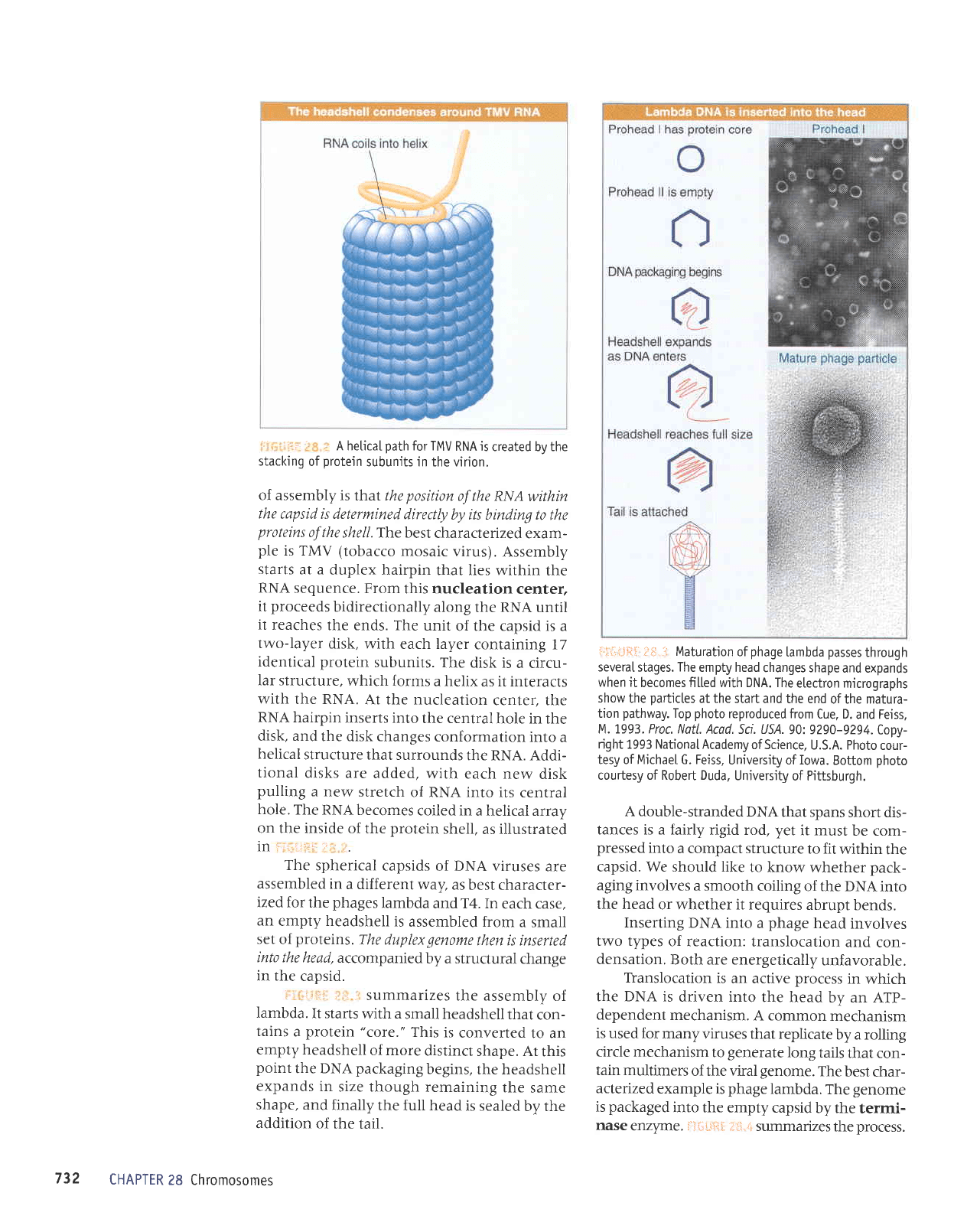
:
:
,.':-ii
.:
A hetical
path
for TMV
RNA is
created by the
stacking
of
protein
subunjts in the virion.
of assembly
is that the
position
of the RNA
within
the
capsid is determined
directly
by its binding to
the
proteins
of the
shell. The best
characterized
exam-
ple
is TMV
(tobacco
mosaic virus).
Assembly
starts
at a
duplex hairpin
that lies within
the
RNA
sequence.
From
this nucleation
center,
it
proceeds
bidirectionally
along
the RNA until
it reaches
the ends. The
unit
of the capsid is
a
two-layer
disk,
with each layer
containing 17
identical protein
subunits.
The disk is
a circu-
lar structure,
which
forms
a
helix
as it interacts
with
the RNA.
At the nucleation
center, the
RNA
hairpin
inserts into
the central
hole in the
disk, and
the disk changes
conformation
into
a
helical
structure that
surrounds
the RNA. Addi-
tional
disks
are added,
with each new
disk
pulling
a new
stretch
of RNA into
its central
hole.
The RNA
becomes
coiled in
a helical array
on the inside
of the
protein
shell.
as illustrated
in itr,l.,,r',l::',
,.
The
spherical
capsids
of DNA viruses
are
assembled
in
a different
way,
as best character-
ized for
the
phages
lambda
and T4. In
each case,
an
empty headshell
is
assembled from
a
small
set
of
proteins.
The duplex
genlme
then is inserted
into the
head, accompanied
by a structural
change
in the
capsid.
;
i .i.:.::
,
i.
-r
Summarizes
the assembly
of
lambda.
It starts
with a
small headshell
that
con-
tains
a
protein "core."
This
is
converted
to an
empty headshell
of more
distinct
shape. At
this
point
the DNA
packaging
begins,
the headshell
expands
in
size though
remaining
the
same
shape,
and
finally
the full head
is sealed
by the
addition
of the
tail.
CHAPTER
28 Chromosomes
r:'i;i,Jir!
;$.:t
Maturation
of
phage
[ambda
passes
through
several
stages.
The
empty head
changes shape
and expands
when it
becomes fitted with DNA. The
etectron
micrographs
show
the
partictes
at the start
and the end
of the matura-
tion
pathway.
Top
photo
reproduced from
Cue, D.
and Feiss,
M. 1993. Proc. Natl.
Acad. Sci. USA.90:9290-9294.
Copy-
right
1993 National Academy
ofScience,
U.S.A. Photo
cour-
tesy of Michael G. Feiss,
University of Iowa.
Bottom
photo
courtesy of Robert Duda,
University
of Pittsburgh.
A double-stranded
DNA
that spans
short dis-
tances is a fairly
rigid rod,
yet
it must
be com-
pressed
into
a compact structure
to fit
within
the
capsid. We should like
to know
whether
pack-
aging involves
a
smooth coiling
of the DNA
into
the head
or whether it requires
abrupt
bends.
Inserting
DNA into
a
phage
head
involves
two types
of reaction:
translocation
and
con-
densation.
Both are energetically
unfavorable.
Tlanslocation
is
an active
process
in
which
the DNA is
driven into
the head
by an
ATP-
dependent
mechanism.
A common
mechanism
is used
for many
viruses that replicate
by a rolling
circle
mechanism
to
generate
long
tails
that con-
tain multimers
of the
viral
genome.
The
best
char-
acterized
example
is
phage
lambda.
The genome
is
packaged
into the
empty capsid
by the
termi-
nase
enz).rne. il{illlit
i:rii.i summarizes
the
process.
732
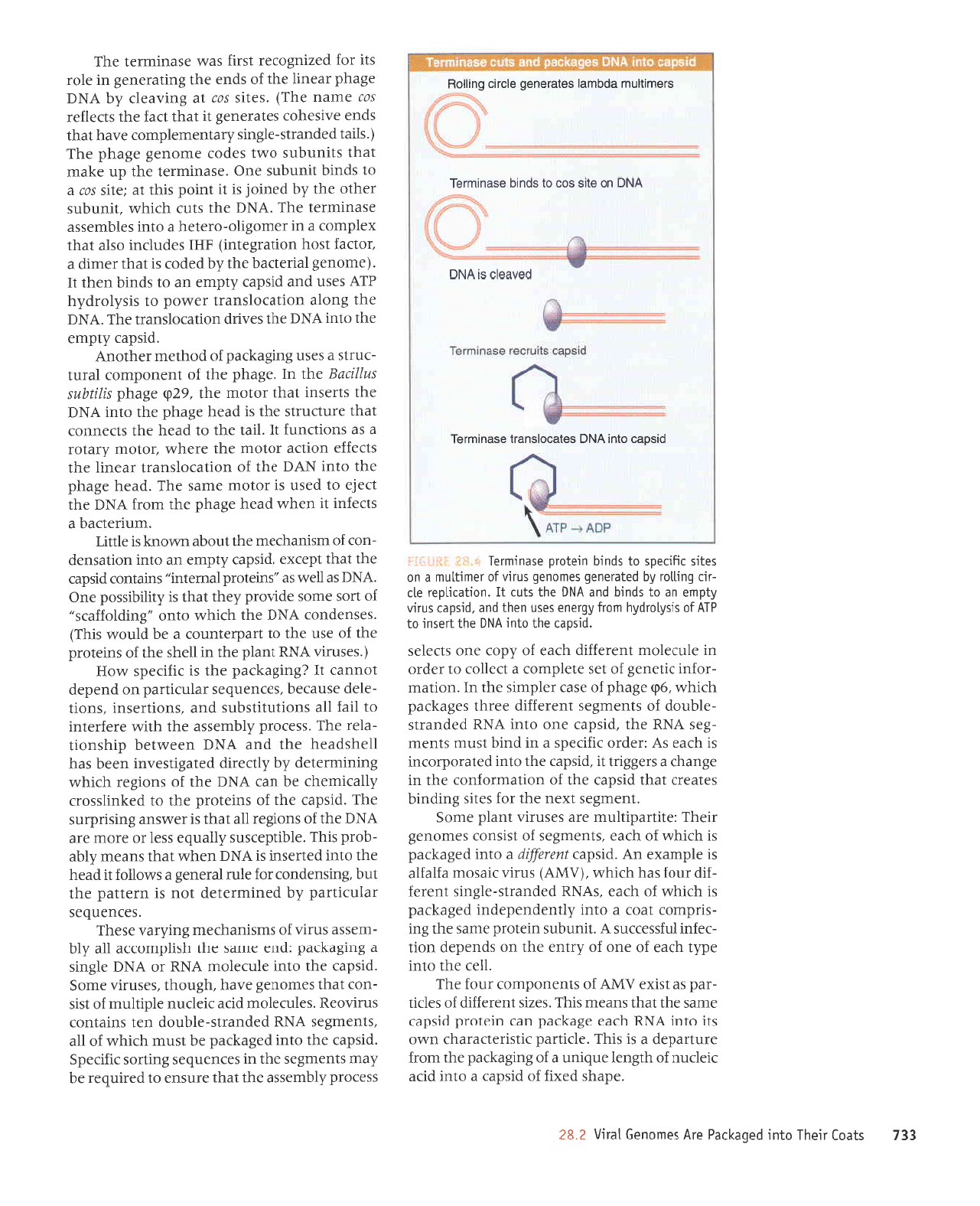
EEL
slPol traql olul
pabelled
elv
sauouag
lpll^
z'gz
'JdPqs
pexrl
Jo
prsdeJ
e otul
plre
Jralrnu
Jo efual
anbrun e;o SurSeped aqr
ruo.t;
arngedap e sr srqJ
'alrrued
JltslrappJpqf,
uluro
sll
olq
YNIU
qlPe
a8e4red uer urelord
prsder
Jlues 3q1
leq1
sueJru
srqJ'sJzrs
luJralJrp
Jo
salJll
-.red
se
tslxa
AWV;o
sluauodruol JnoJ
JqJ
'll3)
aql
olul
ed,ri.t
qrea
Jo
Juo
;o
.drlua
eqt uo spuadap
uotl
-JJJur
InJssJ))ns
V
'lrunqns
uralord arues
aql 8ut
-srrdruor
leoJ
e
orul
[ltuapuadapur
pa8elred
sr
qlrqM
Io
q)ee
's1trNg
papuerls-a13urs
tuereJ
-Irp
JnoJ seq
qJrqM
'(.rt
WV)
snrrn Jresour
eJIeJIe
sr aldruexa uy
'prsder
patallp
e otur
pa8eped
sr
q)rqM
Jo
q)ee
'sluaru8as
Jo
lsrsuo)
saruoua8
JreqJ
:Jlrupdlr1nu
aJe sesnrrl
tueld
auo5
'luaru8as
txJu
Jr{t roJ setrs Surpurq
sJleaJf,
reqr
plsder
Jql
Jo
uorlpruJoluoJ
eqt
uI
a8ueqr e sra33rr1
1r
'prsder
Jqt olur
paterodrorut
sr
qJeJ
sv
:JapJo
rryrads
p
ur
purq
tsnlu
sluJur
-3as
VNU
aqt
'prsder
Juo otur
VNU
pepuerts
-elqnop
;o
sluaru8as
tuJrJJJrp
aarqt sa8eped
qJIqM
'9d
a8eqd
Jo
JSel raldrurs Jql
uI'uolteu
-JoJur
JrlJueS
10
1as
alaldruor P
pelloJ
o1 raplo
ur JInJJIoru
luJJJJJrp
qJpJ
Jo
,{dor auo
slJJIes
'ptsder
aq1 olul
VNC
eql
t.rosut
ol
61y;o
srsflorpfiq Luor; [6raua sosn uaql
pue
'pLsder
snttn
r\1due
ue 01 spurq
pup
VNq
aql slnr
11'uorlerqdar
e1r
-.ro
6ur11or [q
paleraueO
sauoueb snrrA
Jo
lourrllnu
p
uo
soJts llJtle0s ol
Sputq u!A1ol0 aseutulJOf
r,
,,,, ,i;i:'l:lT:i
ssarord,{lqruesse
aql
teqt
aJnsue o1
parmbar
aq
.{eru stuaru8es
eql
uI satuanbas
Sutuos rqtradg
'prsder
eql otul
pa8e>1red
Jq
tsnru
qllqm
Jo IIP
'sluaru8as
VNU
papuerls-Jlqnop ual suletuo)
snJrloaU
'sJInJJIoIu
pIJe
)IJpnu aldplnru;o
tsts
-uoJ
tpql
saruoua8
aneq
'q8noql
'sJSnJI^
JItroS
'prsder
rql olq eln)Jlorr
VNU
ro
y51q
a13uts
e Eur8elred
:puJ Jlrrps aqt
qsgdurorre
p
.{1q
-urJSSe
snJrl
Jo
slusrueq)elu
Surl.rerr
asaql
'saruanbas
relnrrlred
z(q
pauturalap
tou
st uralled
aql
1nq
'SursuapuoJ
JoJ
alnr
prauaE
p
sMolloJ
ll
peaq
rql otq
pJuasul
sl
YN61
uJqM
teql
suearu
z(1qe
-qord
srql
'alq1ldaJsns,ri.lenba
ssel ro
JJour eJe
VNC
Jqt
yo
suofar
ile
leql
sI
reMSuP Surstrdrns
aql
'prsder
aqr
Jo
sutalo.rd
aql ot
pe>lullssor)
.{lernuaqr
aq upJ
VN(
Jq1
;o
suot8ar
rlllqm
Surunu.ralap
dq,{loartp
pa1e8t1sa.tu1 uaeq seq
Ilrqspeaq
eql
pue
VNO
urrMtaq
dlqsuotl
-elJJ
eqJ
'ssarord
z(lqruasse aq1
qilM
eJaJrJtuI
01
IreJ IIP
suollnlllsqns
puP
'suoluJsul
'suo]l
-elep
JSneJeq
'saruanbas
:elnrtped
uo
puadap
touueJ 11
a8ur8elled
aqt s1 rtJtrads
mog
('sasnl,r
y1qg
1ue1d
eql
ur
ileqs
aq1
1o
sulatord
eql
Jo
Jsn aqt ot
uedtalunoJ
e aq
ppozu
sql)
'sesuepuor
vNO
aqt
qJIqM oluo
,,3urp1o;prs,,
Jo
lJos
eruos epIAoJd
daql
leql
sl
,{lrlqrssod aug
'VNO
sp
IIJM
se
,,srnalord
1pluJrr,,
srneluor
ptsder
eqr
l€qt
ldalxa
'prsdel
zhdrua u€ otul
uollesuap
-uoJ
Jo
rusuPqJaru
Jql
lnoqe
U^AOIDI sI
JI]1I'I
'[unrJJlJPq
e
slleJur
1I
ueq,!\
peaq
aEeqd
aql
ruorJ
VNC
rqr
Da[a
ot
pasn
sI Jotoul
erups
JqJ
'peaq
a8eqd
eql
olur
NV(I
Jq1
Jo
uollPJolsuPJl
JPeUII
eq1
speJJJ
uortJe
roloul eql
JrJqM
Jolotu
,{relor
e se suorlJun]
1I
'ilel
Jql
01
peaq
eq1 slJeuuoJ
teqt
JJnpnrls
aql
sI
peaq
a8eqd
eqr olul
VN(
rql sursur
tpql
rolour eql
'626
aSeqd s!il|qns
snlu)Dg
aql
q
'a3eqd
aql
Jo
luauodruor
prnl
-JnJts p
sasn
Sur8eped;o
poqraru reqlouv
'prsder
z(tdrua
Jql
olul
VN(
rq1 sa^Irp
uollProlsueJr
eqJ,'YNq
aql
3uo1e uoltpf,olsue;l
rau.od
ot stsdlorp,{.q
dJv
sJSn
pue
prsder
.&drua
ue ot
spulq ueqr
tI
'(aruoua8
1errJlrpq
aqr
,i.q
papor
sI
leqt
Jaulp
E
'ro1reJ
lsoq
uotler8atul)
gtl
sepnlJul
osp
leql
xaldruor
p
ur JeruoBIIo-oJJlJq
P olul
sJlqluJsse
aseururrJt
Jr{I
'vNa
Jql
sln)
qllqM
'llunqns
Jaqto
aql
.dq
paurof sg
11
turod
slql
le
1J1IS
so, e
01 spurq
llunqns
auo
'JsPuIurJl
JI{}
dn a4eur
leql
stlunqns
o.tr1
sepoJ
Jluoua8
a8eqd aq1
('sger papue.rls-a13uts
fueluauraldurol
eleq
leql
spua
rnrseqor
saleraua8
1l
tpql DeJ
aqt
sDalJaJ
ro, eurpu
aq1)
'sa1rs
soc
fe
Sutteap
u(q
y51q
a8eqd JeJull
eqt
Jo
spur
Jqt SullereuaS
ut alor
slr
JoJ
pezluSo)eJ
tsJlJ
sPM
aseulurrJl
aqJ
prsdec
olur
VNO
solecolsueJl aseururej
po^eolc
sr
vNc
vNc
uo olls soc ol spurq aseururJol
sror.urllnui epquel selereueb elcrrc
6ur11og
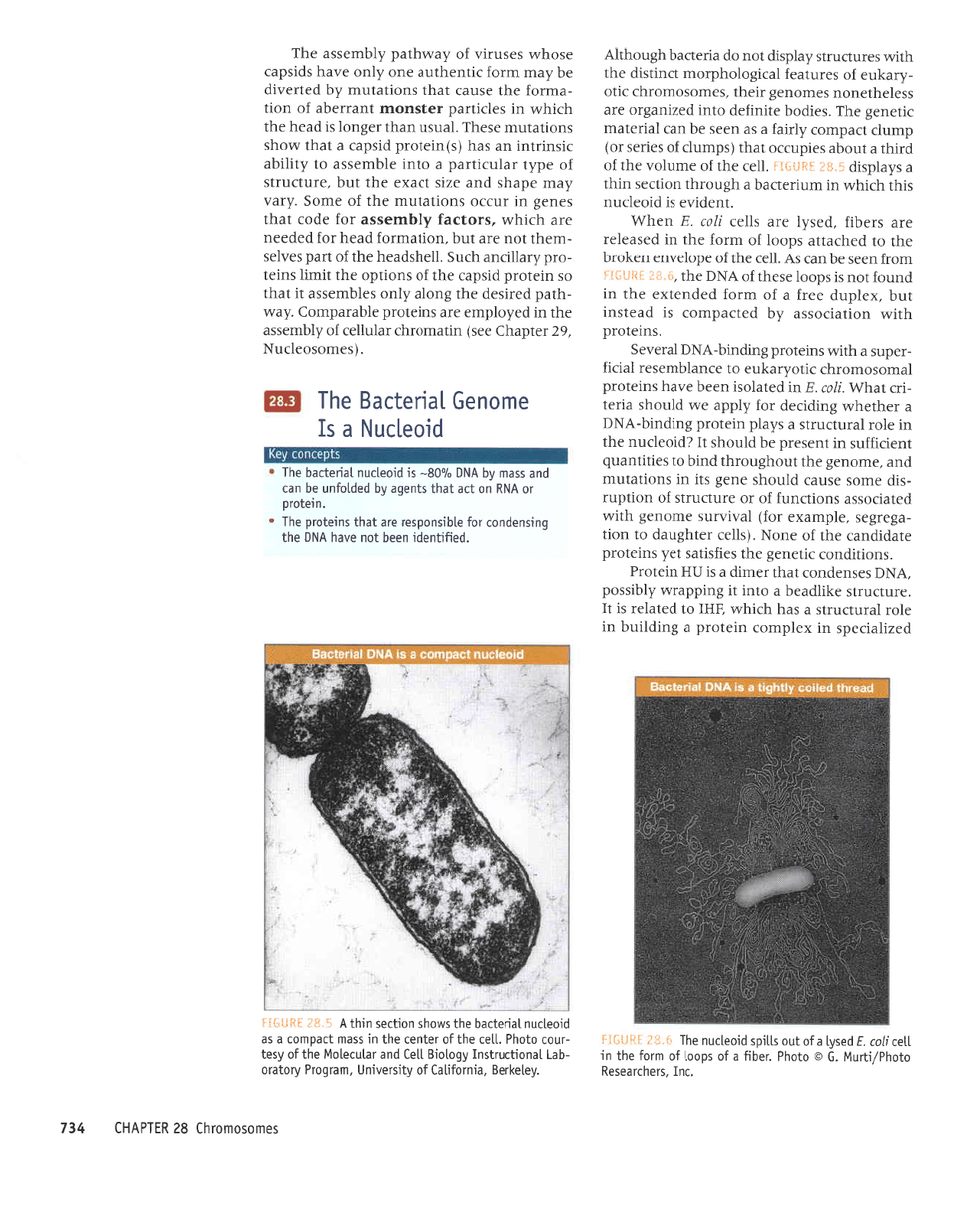
'luI 'slaqlleeseu
oloqd/qrnw
'!
o
oloqd 10q!J
p
Jo
sdool
jo
uuoJ aql ur
ller
4olf
posfl
p
Jo
lno
qlrds
proallnu
eql
+'f i
*ul]*i
j
pazrler)ads
ur xeldluo)
uratoJd
e Surplrnq
ur
AIOJ
IPINIJNJ]S
E SEq
qJIqM
{HI
01
PJ]EIEI
SI
U
'alnlf,nrls
J>lrlppaq
p
olul
tI
Surdder.t,{lqrssod
'vNo
sasuapuoJ
]eql
JJrurp
e sr
nH
urJloJd
'suorlrpuoJ
r11aua3
Jql sarJsrlps
la.{.
surato,rd
atpprpueJ
Jqt
Jo
auoN
'(s11ar
ralq8npp
01 uorl
-e8ar8as
'aldruexa
ro1)
le,l,rnrns
aruoua8
qtr^,l1
pJlprJossp
suorlJunJ
Jo
ro
JJntJntls
Jo
uorldnr
-srp
euos
esneJ
plnoqs
aua8
str ur suorlptnru
pue
'aruouJ8
aql
lnoq8noJqt
purq
ol
sertrlupnb
tueprlJns
u1
luasard
aq
plnoqs
1I
ZproalJnu
Jql
ur alor
I€JnlJnJts
e
sLeld uratord
Surpurq-ygq
p
rrqtaqM
Surpnap
roy [1dde
e,lr
plnoqs
errr]
-IJJ
leq6
'llu
'g
ur
patelosr
uJJq
alpq suratord
Ieuosouorqr
lr1o.{re>1na
01 eJuelquesJJ
ler)rJ
-radns
e
qlrm
suralord
Surpqq-VN(
IpreAJS
'sur:10,rd
qlIM
uorleDosse
.{.q
palredruor
sr
pealsur
1nq
'xaldnp
aaJJ
e
Jo
ruroJ pJpualxa
Jql
ul
punoJ
tou
sr sdool
eseql
Jo
VNCI
eqt
,t-;-Ffl
Gldil*t.j
ruoJJ
ueJs aq
ueJ sV
'llJJ
aq1
yo
adolanuJ
uJ>loJq
eql ot
peqJeltp
sdool yo
ruJoJ
eqt
ur
paspalar
Jr€ sJJqrJ
'pasz(1
ere
sllal
lln
'E
uJqM
'lUJprAJ
Sr
pTOJIJnU
slql
qJIqM
ur
runrJel)eq
e
q8norql
uorlJes urql
e sz(eldsrp
S'Sf
ESfi5:j
'llel
aqt
Jo
lunlo^
eqt
Io
prqt
e
lnoqe
sardnr)o
leqt
(sdrunlr;o
sarras ro)
drunp
Dedurol
.d1le;
e
se ueJS
Jq ueJ
lprJJleru
rllaua8
JqJ'sapoq
elrurJJp
olur
pazue8Jo
JJe
ss3lJqlauou
sauroua8
JrJql'seurosourorqJ
Jrlo
-Lre>1na
Jo
saJnteal
prrSoloqdrou
Durtslp
Jql
qllzlr
saJruJnrls,{eldsrp
1ou
op
errarreq q8noqlly
sauosoruor.ll
8z
ulldvHl
'r{eleuag'prutojrl
pl
;o
rtlrsra,uu
6'
Lu et 6o16 firolero
-qel
lpuorlrnrlsul
r\6o1o19
llal
pue
lplnralo111 aq1
1o
Asal
-.lnol
oloqd
'llel
eql
Jo
rolual
aql ur sseul
lreduor
e se
proalrnu
lPualrPq
oql sMoqs
uorllas urql
v $"sr
jHflslj
'palJquapl
uaaq
lou
a^Pq
vN0
aql
6ulsuapuor ro; alqrsuodsat
alp
lpql
suralord aq1
'ura10t0
ro
VNU
uo
pe
lpql
sluabe
r{q paploJun
eq uel
pup
sspru Aq
VNO
V"Og-
sr
proallnu
lpuelrpq
aql
proallnN
P
sI
auloua9
lPuapeg
aql
'(saluosoJI)nN
'69
raldeq3
aas) urleruorqJ relnlleJ;o
z(lqruasse
aqt
ut
pa.{oldura
are suralord alqereduro3
',{.eal
-qted
parrsrp
rr{l
Suolp .d1uo salqruasse
tl
teql
os uralord prsder
aql
;o
suorldo Jqt
llru{
sutal
-ord
zhelnue qtns
'flaqsperq
Jql
]o
upd
sJAIrs
-ruaql
lou
JJp
lnq
'uorleluJoJ
peaq
JoJ
pepJau
JJe
qlrqM
'srolJpJ
Llqurasse
JoJ epo)
tpql
saua8
ur JnJJo
suorlelnru Jql
;o
aruog
'z(re,t
,{eur
adeqs
pue
JZrs
lJexe
Jqt
tnq
'eJnlJnrts
yo
adLl
relnrrlred
e olur Jlqruasse
o1 ,{1rlqe
Jrsurrlur
ue
seq
(s)uralord
prsder
e
leql
,lroqs
suorlelnru
esJqJ
'lpnsn
upql JJBuol
sr
ppJq
Jql
qJIqM
ur salrrt:ed
ralsuoru
lupJJeqe
Jo
uoll
-euroJ
eql asneJ
teql
suortptnu ,{q pJuJ^rp
aq,{eru uroJ
JrtuJqlne
auo
z{1uo
aneq
sprsder
esoqM
sesnJrl yo ,{euqled
Llquasse
aql
,EL
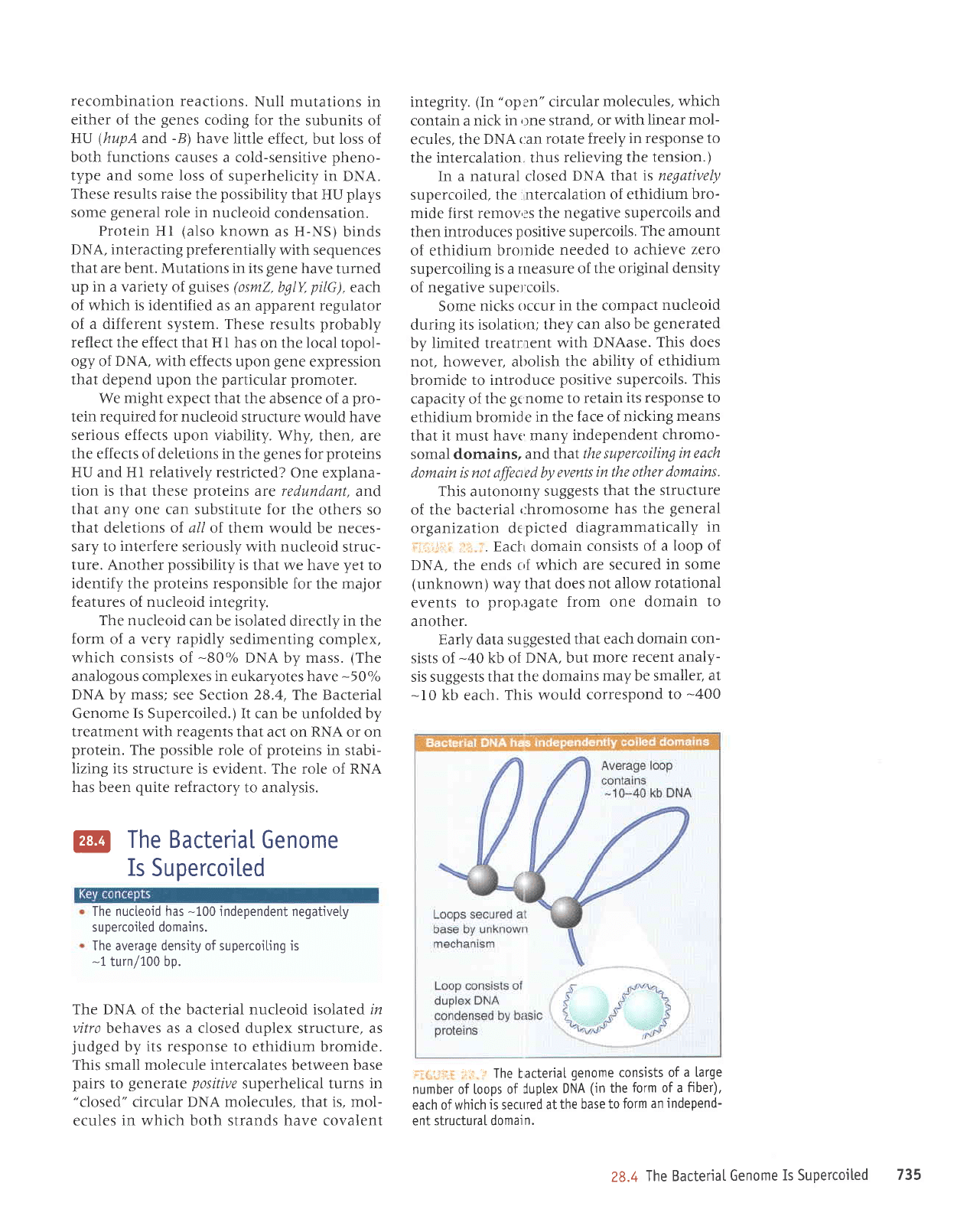
recombination reactions.
Null
mutations
in
either of the
genes
coding
for the
subunits of
HU
(hupA
and
-B)
have little
effect, but loss of
both functions causes
a cold-sensitive
pheno-
type and some loss
of superhelicity
in DNA.
These results raise
the
possibility
that HU
plays
some
general
role in nucleoid
condensation.
Protein HI
(also
known
as
H-NS)
binds
DNA,
interacting
preferentially
with sequences
that are bent. Mutations
in its
gene
have
turned
up
in
a variety of
guises
(osmZ,
bglY,
pilG),
each
of which is identified
as an apparent regulator
of a different system. These
results
probably
reflect the effect
that Hl has on
the
local
topol-
ogy of DNA, with effects
upon
gene
expression
that depend upon the
particular promoter.
We
might
expect that the absence
of a
pro-
tein required for nucleoid
structure would have
serious effects
upon viability. Why, then,
are
the effects of deletions in the
genes
for
proteins
HU and Hl relatively
restricted? One explana-
tion
is
that these
proteins
are redundant,
and
that any one can substitute for
the others so
that deletions of. all
of them would be neces-
sary to
interfere
seriously with nucleoid
struc-
ture. Another
possibility
is
that we have
yet
to
identify
the
proteins
responsible
for the major
features of nucleoid integrity.
The nucleoid
can be isolated
directly
in
the
form of a very rapidly sedimenting
complex,
which consists
of
-80%
DNA by mass.
(The
analogous complexes in eukaryotes have
-507o
DNA
by
mass;
see Section 28.4, Thre Bacterial
Genome
Is
Supercoiled.) It can be
unfolded
by
treatment with reagents that
act on
RNA
or on
protein.
The
possible
role
of
proteins
in stabi-
lizing its
structure is evident. The role of RNA
has
been
quite
refractory
to analysis.
@
The Bacterial
Genome
Is
SupercoiLed
The nucteoid has
-100
independent negativety
suoerco'ited domains.
The average density of supercoi[ing is
-1
turn/100 bo.
The DNA of the bacterial nucleoid isolated in
vitro
behaves
as a
closed duplex structure, as
judged
by
its response
to ethidium bromide.
This
small
molecule intercalates
between
base
pairs
to
generate positive
superhelical turns in
"closed"
circular DNA molecules,
that
is, mol-
ecules in which both strands have covalent
integrity.
(In
"op:n"
circular
molecules,
which
contain a nick
in
r)ne
strdr-Id, or
with linear
mol-
ecules, the
DNA can
rotate freely
in response to
the intercalation, thus
relieving
the tension.)
In
a
natural closed
DNA that
is negatively
supercoiled,
the . ntercalation
of ethidium
bro-
mide first
remov,3s the
negative supercoils
and
then introduces
positive
supercoils.
The amount
of ethidium brornide
needed to
achieve zero
supercoiling
is
a
rneasure of
the original
density
of negative supelcoils.
Some nicks
occur
in the compact
nucleoid
during
its isolation; they
can also
be
generated
by limited treatnent
with
DNAase.
This does
not, however, abolish
the
ability of ethidium
bromide
to introduce
positive supercoils.
This
capacity of the
gr
nome to
retain
its response to
ethidium bromide
in the
face of nicking
means
that
it must havc many
independent
chromo-
somal domains,
and that
the supercoiling
in each
domqin
is not affeaed by
events
in
the
other domains.
This autonolny
suggests
that
the structure
of the bacterial
r:hromosome has the
general
organization de
picted
diagrammatically
in
iii,,ii:ii:
,r::r
.'
.
puar,
domain
consists
of a
loop of
DNA, the ends c,f
which are
secured
in some
(unknown)
way
that does
not allow
rotational
events to
prop,igate
from one domain
to
another.
Early data
suggested
that each
domain
con-
sists of
-40
kb of
DNA, but
more
recent analy-
sis suggests
that the domains
may be smaller,
at
-10
kb each.
This would
correspond
to
-400
;
I
11:,::
'r'i
:
The
Lacterial
genome consists of
a large
number of loops of
luplex
DNA
(in
the
form of a fiber),
each of which
is
secured
at
the base
to form
an independ-
ent structuraI domain.
28.4
The Bacterial
Genome
Is Supercoited
735
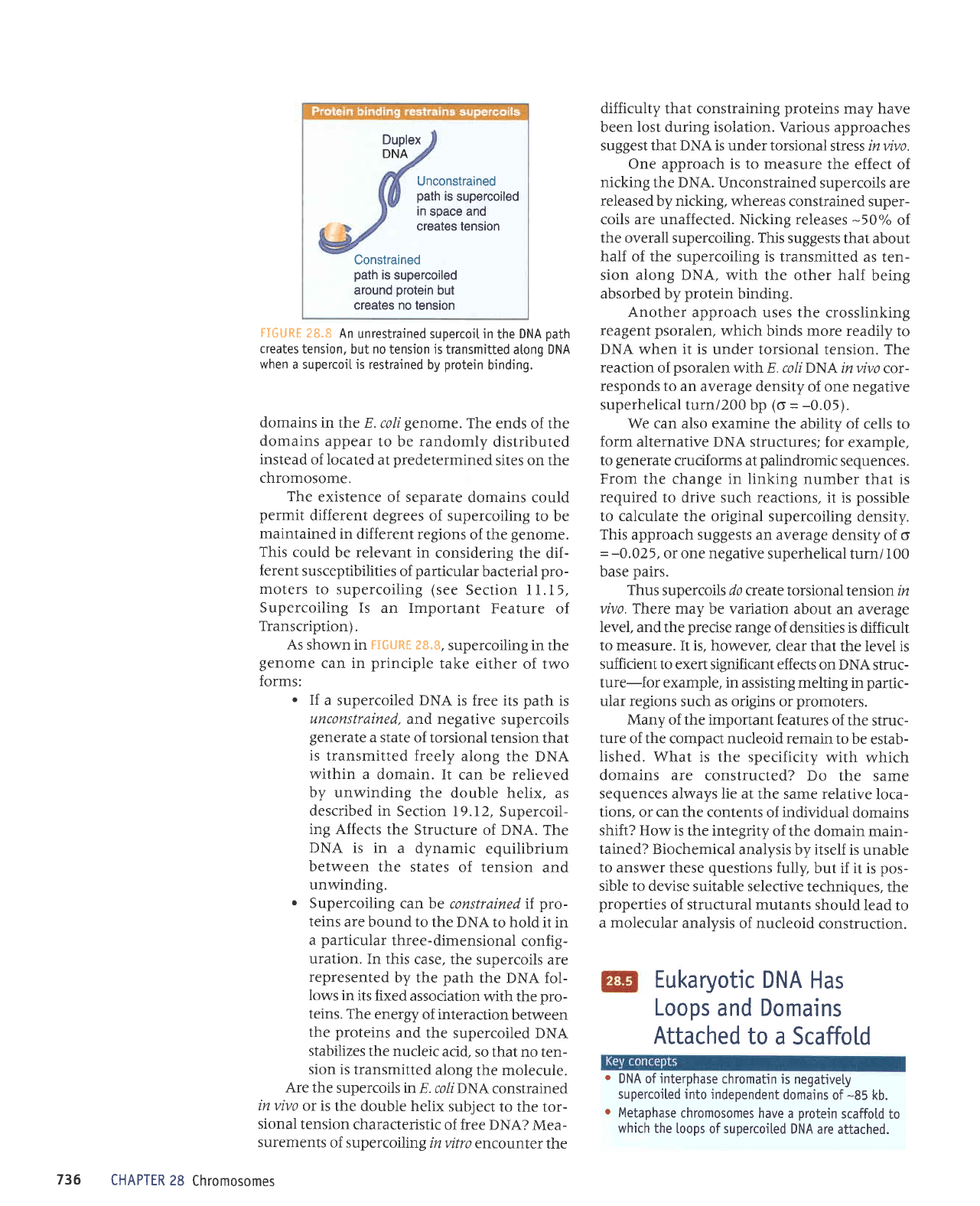
Duplex
DNA
Unconstrained
path
is
supercoiled
in
soace and
creates tension
Constrained
path
is
supercoiled
around
protein
but
creates no tension
fIGURf
28.8
An
unrestrained supercoil in
the
DNA
path
creates
tension,
but
no
tension is transmitted
along
DNA
when
a supercoiI is restrained
by
protein
binding.
domains
in the E.
coli
genome.
The
ends of the
domains
appear
to be randomly
distributed
instead
of located
at
predetermined
sites on the
chromosome.
The
existence
of separate
domains could
permit
different degrees
of supercoiling
to be
maintained
in
different regions
of the
genome.
This could
be relevant in
considering the
dif-
ferent
susceptibilities
of
particular
bacterial
pro-
moters
to supercoiling
(see
Section ll.l5,
Supercoiling
Is an Important
Feature
of
Transcription).
As
shown in
FI$URI 2&.*,
supercoiling
in the
genome
can in
principle
take
either of two
forms:
.
If
a supercoiled DNA
is free its
path
is
unconstrained,
and negative
supercoils
generate
a state
of torsional
tension that
is
transmitted freely
along
the DNA
within
a domain. It
can be relieved
by unwinding
the double
helix, as
described in
Section 19.12,
Supercoil-
ing Affects
the
Structure of DNA.
The
DNA
is in
a dynamic
equilibrium
between
the states
of tension
and
unwinding.
.
Supercoiling
can be
constrained if
pro-
teins
are bound to
the DNA
to
hold
it in
a
pafiicular
three-dimensional
config-
uration.
In this
case, the
supercoils are
represenred
by the
path
the DNA fol-
lows in
its fixed
association
with the
pro-
teins.
The energy
of interaction
between
the
proteins
and the
supercoiled DNA
stabilizes
the nucleic
acid,
so that no ten-
sion is
transmitted
along
the molecule.
Are
the supercoils
in E. coli DNA
constrained
in vivo
or is
the double helix
subject
to the tor-
sional
tension
characteristic
of free DNA?
Mea-
surements
of supercoiling
in vitro
encounter
the
CHAPTER 28
Chromosomes
difficulty
that constraining
proteins
may have
been
lost
during isolation. Various approaches
suggest that DNA is under torsional
slress invivo.
One approach is to measure
the effect
of
nicking
the DNA. Unconstrained
supercoils are
released by nicking, whereas
constrained super-
coils are unaffected.
Nicking releases
-5oo/o
of
the
overall supercoiling. This suggests
that about
half of the supercoiling is
transmitted as
ten-
sion along DNA, with the other half
beino
absorbed
by
protein
binding.
Another
approach uses the
crosslinking
reagent
psoralen,
which
binds more readily
to
DNA
when
it is
under torsional tension.
The
reaction
of
psoralen
with E. coli DNA
in
vivo
cor-
responds to an
average density of one negative
superhelical turn/200 bp
(o
=
-0.05).
We can also examine
the ability of
cells to
form alternative DNA
structures; for
example,
to
generate
cruciforms at
palindromic
sequences.
From
the change in linking
number
that is
required
to drive such reactions, it
is
possible
to calculate the
original supercoiling
density.
This
approach suggests an average
density
of o
=
-0.025
,
or one negative
superhelical
turn/ I 00
base
pairs.
Thus
supercoils /o create
torsional tension in
vivo. There may
be variation about
an average
Ievel,
and the
precise
range of
densities is difficult
to measure. It is,
however, clear
that the level is
sufficient
to exert significant effects
on DNA
struc-
ture-for example, in
assisting melting in
partic-
ular regions
such as origins
or
promoters.
Many of the important
features
of the struc-
ture
of the compact nucleoid remain
to be
estab-
Iished.
What is the specificity
with
which
domains are
constructed? Do
the same
sequences always lie at
the same relative
loca-
tions, or can the
contents of individual
domains
shift? How
is the integrity
of the domain
main-
tained? Biochemical
analysis
by
itself
is
unable
to answer
these
questions
fully,
but if it
is
pos-
sible to
devise suitable selective
techniques,
the
properties
of structural mutants
should
lead to
a
molecular
analysis
of nucleoid
construction.
Eukaryotic
DNA
Has
Loops
and
Domains
Attached
to a Scaffold
e
DNA ofinterphase
chromatin is
negativety
supercoi[ed into independent
domains of
-85
kb.
r
Metaphase
chromosomes
have a
protein
scaffotd
to
which the
loops of supercoited
DNA are
attached.
736
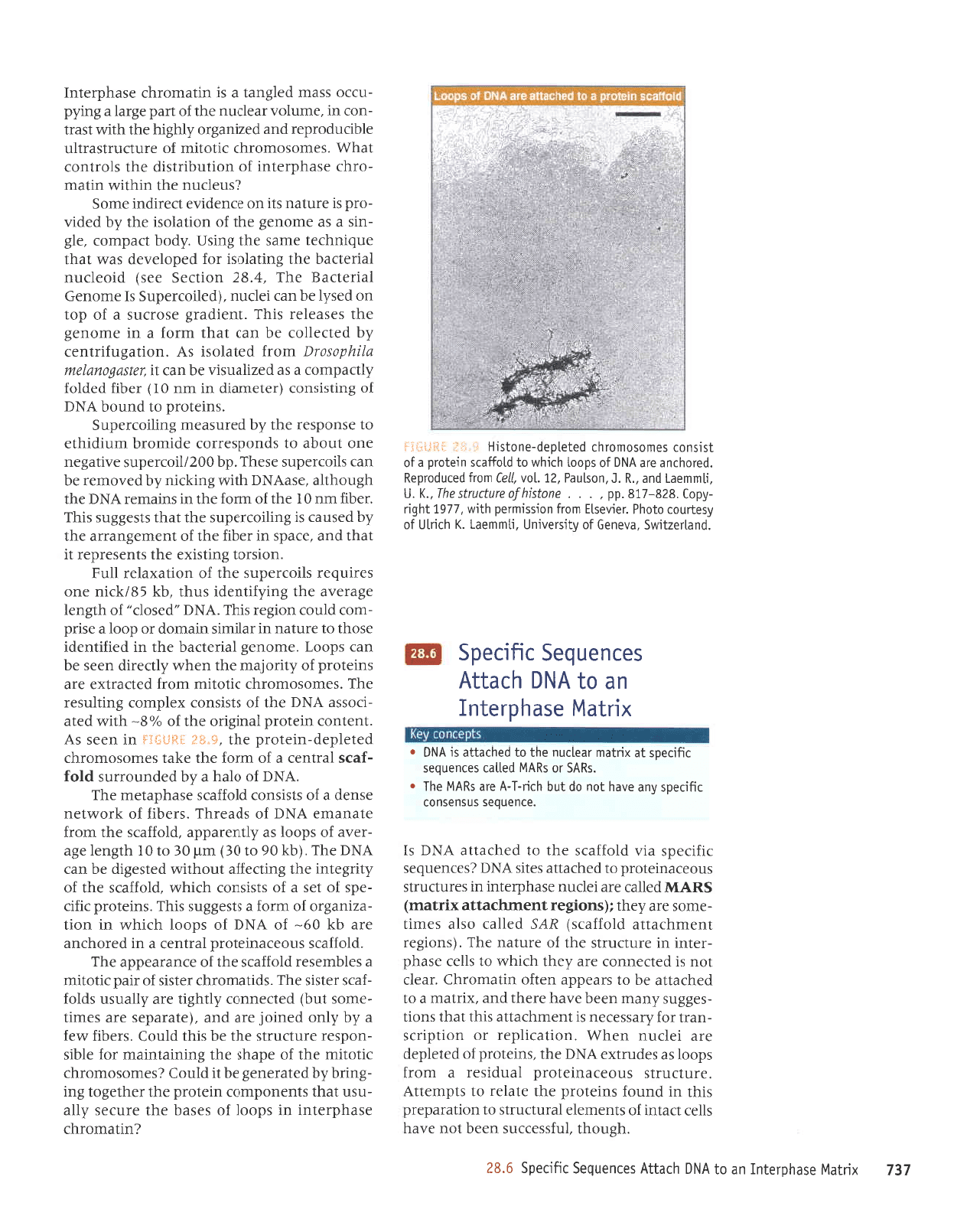
LEL
xr.rlp14
aseqdlelul
up ol
VN6
qlellv
seluanba5:gL:ad5
9.97
'q8noql
'lnJssJrrns
ueaq
lou
JAPq
slleJ
ttelul
Jo
sluJruelJ
lpJntJnrts
o1 uoperedard
srql
ur
punoJ
suralord
aqt JlelJJ ol sldtuanv
'JJnlJnJls
snoJJpuralo,rd
lenprsat
p
ruoJJ
sdool
se sepnrtxe
vNq1
Jqt
'surato,rd;o
pataldap
aJe rel)nu
ueql
'uorlerrldar
.ro uorldrrls
-u€Jl
JOJ z{.resSarau
sr
luJruqf,€lle
srql
leql
suorl
-sa33ns
^dueru
uaaq
eleq JJaqt
pup
'xrJleru
p
ol
pJqJelle
aq
o1 s:eadde uJUo
urleuoJq)
'reep
rou
sr
pet)JuuoJ
e-re .{aqt qrq.u
o1 s11ar aseqd
-JJtul
ul alntJnJls
er{l
Jo
JJnteu aq1
'(suor8ar
lueruqrelle
p1o11ers)
d'ys
pelle)
osle se111ll
-Juros
are ^daqt
l(suor8al
lueurqJege
xgrleru)
SUyI{
percJ
aJp rJpnu
aseqdralur ur sJJnlf,nJls
snoaf,purJloJd
ot
paqreue
sJlrs
VNO;saruanbas
l;nads
er^
ploJJpJs
eqt ot
paqJplle
vNO
sI
'eruanbas
snsuasuol
rqoeds Aue
eneq
lou
op
lnq
qrg-l_-V
ole SUVW aq1
.
'suvs
ro suvl/\l
pallPr
saluonDes
lqtlaos
]e
xuleu
lPallnu eql
01
paqlPne
st
VNC
.
xr.rlPli\l
asPqdlolul
uP
0l
vN0
qreltv
saluanbes
llJt]ads
'puPuazlrMS
'e^0ua9
Jo
Alrsle^rufl
'rtuuapl ')
r..llpln
Jo
Asalnor
oloqd lor^asll
ulolJ uorsstultod
qlLrn
'1t61
lqbu
-Adol
'828-lI8 'dd '
"
'
auolslq
{o
arnpnqs aLlf
"\'n
'rlrluael
pue
"u
'f 'uoqned
'zl'lo^'nal
uotl
pernpoldax
'poloqlup
arp
VN6
1o
sdool
qrrqM
ol
plo#ers
urelord e
1o
lsrsuorsauosorxotqtpalaldap-auolsr;.1
.irr!1il;.1
zulleIuoJqJ
aseqdralur ul sdool
Jo
saseq aql
arnras .{11e
-nsn
l€ql
sluJuodruoJ
ural0rd aq1 Jeq1e301 3ur
-3urrq
Aq
patBraua8
eq
tl
p1no)
ZsJruosoruoJqf,
)llotFu
aqt
;o
adeqs Jql SululPlurPru JoJ elqrs
-uodsal
eJntJnJls Jqt eq
s1qt
p1no)
'sreqrJ
.tra;
e Iq zlpo
paurol
ale
pup
'(aleredas
eJB serurl
-auros
1nq)
parrauuoJ
^llq8rl are ,{.1ensn splo;
-JeJS
JJlsrs eqJ
'spueuoJqf,
Jalsrs
;o
rrcd
rrlolrur
e selquaser
ploJJeJs
aql
Io
aJuPJeadde aq1
'ploJJpJS
snoeJeuretord
lerluar
p
ur
pJroqJup
JJe
q>l
09-
Jo
vN11
Jo
sdool
qrrqm
ur uoll
-ezrue?Jo
Jo
ruJo} e slsaSSns srqJ
'suratord
rqtr
-ads
yo
tas
p
Jo
slsrsuoJ
qJIqM
'ploJJpJs
Jql
Jo
zhrr8alur eq1 SulDaJJe
tnoqtlM
patsa8rp
eq uef,
vNq
rql
'(qa
oe
01
0€ )
lurl
0€
o1
0I
qr3ua1
a3e
-rrnp
Jo
sdool se ^dltuaredde
'ploJJers
Jqt ruoJJ
elpuPlua
vN(
Jo
spesrqJ
'sreqlJ
Jo
>lJo1!l.lau
JsuJp
p
Jo
stsrsuo)
ploJJeJS
aseqdet:ur aq1
'YNO
Jo
oleq e z{q
papunorrns pIoJ
-JeJS
IpJluJJ
e
Jo
rxJoJ aql J>lel
saruosoruoJq)
pataldap-ura1o.rd
aql
'#'.ttr
-4itsgi
ur uees sV
'lualuo)
uralord
leur8rro
Jq1
Jo
%8-
qll,lr pJte
-rJosse
yNq1
eql
Jo
slsrsuoJ
xaldruor
Surtlnsar
eqJ
'sJruosoruorql
JIlolIu ruoJJ
pepeJlxJ
JJe
suralord;o ,{tuoleru aqt uaqa\
,{lnarrp
uJes aq
uer
sdool
'aruoua8
lerJeppq
aql
ut
pelllruJpl
Jsoql ol JJnlpu
ur JplIruIS ul€ruop ro dool e asrrd
-ruo)
plnol
uor8ar
slqJ'vNq
,,pasolJ,,;o
qr8ual
a8ente
aqt 8ur.{;rluapr snqt
'q>l
S8/>pru
ruo
sarrnbar slorradns
Jql
Jo
uollexpleJ
IIn{
'uorsJol
Surlsrxa aql
sluasardar
lr
teql
pue
'areds
ur
JaqrJ Jq1
1o
luarua8ueJJe
Jql
dq
pasner
sr 8u1go;radns
rql
teql
slsaSEns srql
'JeqrJ
luu
0I
rql
Io
ruroJ eql ur sureuer
vN(
aql
q8noqrle
'asevNo
qtl,lr
SuDIJIu,{.q
paaoura;
aq
uer
slorradns Jseql'dq
ggTTltorradns
a,rrleSau
euo
lnoqp
o1 spuodsauoJ
epnuoJq lunlprqla
ot asuodsar aqt
.{q
paJnseeu
3_ullorradng
'sureloJct
01
punoq
vN(
;o
Surtsrsuor
(.ralaruep
uI uru
0I)
rJqIJ
pJploJ
,{lDedruo;
p
se
pazrlensrl
aq ueJ
4'ta1sa6oua1aru
alttldosotq uorJ
pelelosI
sy
'uolle8nJtrtuar
.{q
patrallor
aq up)
teqt
uJoJ e ur auroua8
eql
seseelJJ srqJ
'lualper8
aso.rlns e
;o
do1
uo
pas.{1
aq
ueJ rJlf,nu
'(pagorradns
sI aruouJ1;
Ierrel)pg
eq1-
'r'gZ
uorl)Js aas)
ptoalrnu
IerrJDeq
aqt 3u1re1osr
roy
padola^ep
sp,lr
leql
anbruqrat
Jrues Jql Sursn
'Ipoq
pedruor
'ap
-urs
e sp aruoua8
aql
Jo
uouelosl eqt.{q
papvr
-ord
sr JJnlpu slr uo
eJuJprAJ
Derrpul
eruos
zsnellnu
Jq1 ulqllM ulleru
-orqr
aseqdJelur
Jo
uorlnqrrtsrp
arll sloJluoJ
leqM
'sauosoruoJr{)
JIlolIu
Jo
eJnDnJlseJlln
alqnnpordar
pue panueS:o,{p8rq Jql
qtl,lr
lsprl
-uof,
ur
'Jrrrnlol
JealJnu eqt
Jo
ued
a8rel e 3ur.dd
-n)Jo
sspur
palSuel
p
sI ultpurorqr
aseqdralul
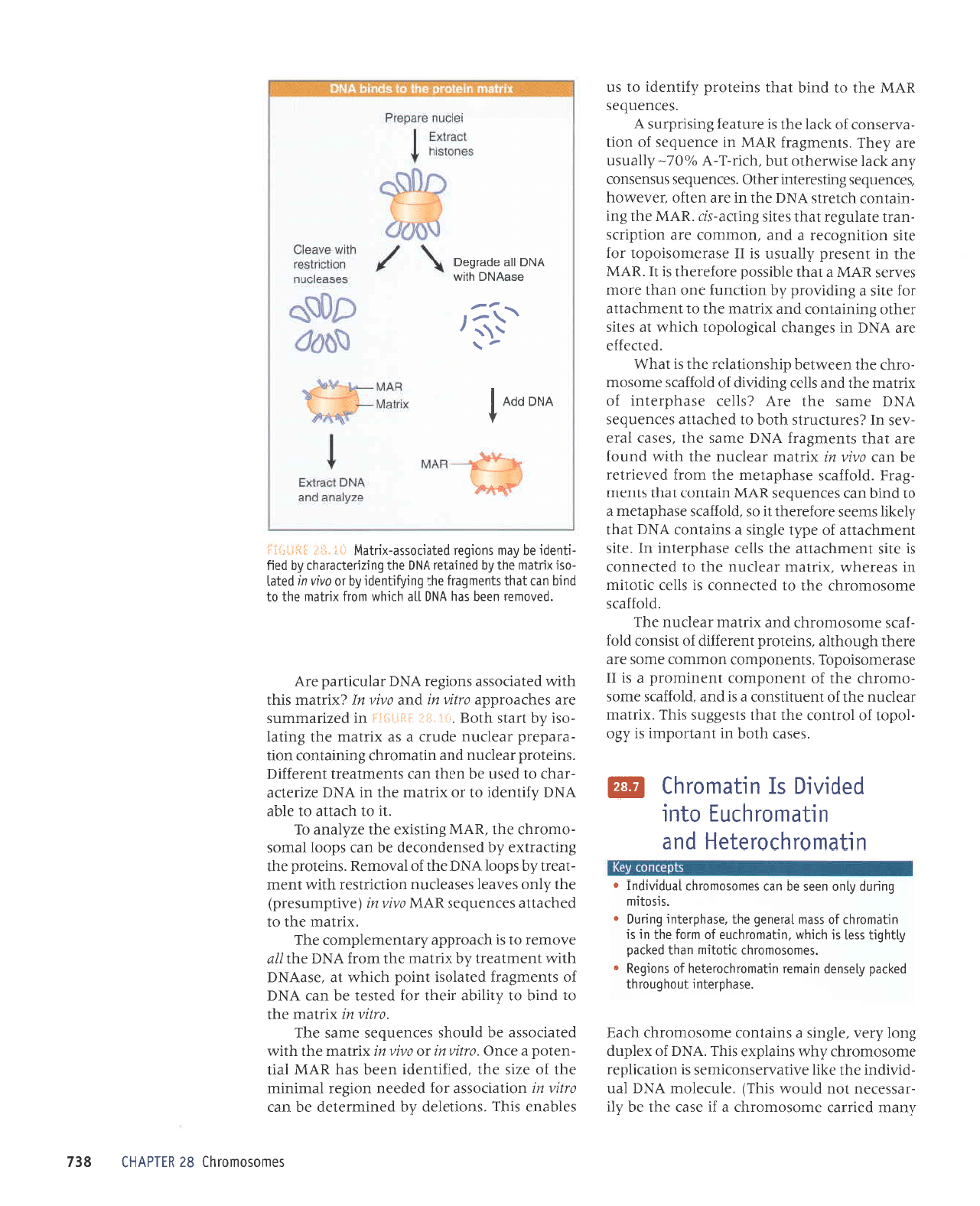
Lueur
paureJ
eurosourorqJ
p
JI
aser aqt aq,{g
-resseJau
lou
plnoM
srql)
'alnraloru
VNO
Ien
-pl^lpul
Jql JIll JArlplJJsuo)rLuJS
sr uone:r1da.r
Jruosouorqr z{q,u
sureldxs srqJ'vNC
Jo
xaldnp
3uo1 Lra,,r
'a13urs
e suretuoJ eurosourolq)
qleg
'eseqd.ralur
lnoq
6norq1
pelred
flasuep ureurer urleuolqlololaq;o
suoLbag
r
'sauosouolql
rqolru ueql
palred
f11qbq ssel sr
qlrqm
'urleuolqlno
Jo
ulloJ aql ur sr
uqeuorql
Jo
sspur
lerauab
aq1
'aseqdtelur
6uunq
o
's
rsolruJ
6uunp fi1uo uaes
oq upl sourosouloLll
lpnprArpul
o
ur.lPruorqlojalaH
pue
uqeuorqrnl
olur
pap!^!0
sI
ur.tPruorql
@
'sese)
qloq
ur
lueuodrur
sr L8o
-lodol
Jo lorluoJ
Jr{t
leqt
slsaSSns srqJ
'xrrteu
JPspnu eql
Jo
luerurtsuoJ
e sr
pup
'ploJJeJS
aruos
-oruoJrlJ
Jr{l
Jo
luJuodruoJ luaururoJd
e sr
II
aseJeuosrodoJ'sluJuodruof,
uourruoJ Jruos aJe
araql
q8noqtle
'suralord
tuJrJJJrp
Jo
tsrsuoJ
ploJ
-JPJS
sruoSOruOJqJ
pue
xrrleur
leJIJnu
JqJ
'ploJJPJs
Jruosoluorqt
Jq1 o1
pJlJauuoJ
sr sllJ) Jllolrur
ur seJJJqM
'xrJleru
realJnu
aql o1
pJlJJuuoJ
sI Jlrs
luaruqJplle
aql sllJJ aseqdratur uI
'Jlrs
tueruqJepp;o
addl a18urs e
surptuof,
VNe
leql
.d1a4l
sruaas erolJreqt
tl
os
'ploJJe)s
aseqdBtaur e
tll
purq
ueJ saruanbas
UvW
urpluoJ
leql
sluJtu
-3erg
'ployye)s
JSeqdelau
aqt utorJ
pJAJrnJr
eq ueJ 2nl\ ut xllleru
JeJIJnu
Jql
qtr1ll puno}
JJe
tpqt
sluaru8ery
VNO
Jues eql
'sJseJ
Iele
-Aes
uI
csJJnlJnJls
qloq
ol
pJqJenp
sJJUJnbJs
vNO
rrups
Jqt JrV
ZSIIJJ
Jspqdrarur
;o
xlrteur eqt
pue
slar Supurp
Jo
ploJJels
Jurosoru
-oJqJ
Jqt
uaJMleq drqsuorlela;
eqt sr
teq6
'pJIJJJJJ
aJe
VN(
ur sa8ueqr
lerrSolodot
qllqu
te
sJlrs
raqlo Surureluo) pup
xrJleur
Jr{t ol
luJruq)ellp
roJ
elrs e Surpnord,{q
uorpun;
auo upql eJou
selJes
UVW
p
reqt
alqrssod JJoJJrJrll
sl
lI'UVW
aqt
ul
luasard
Lllensn
sr
II
aspJJurosrodol
ro;
alls uorlruSoJer
e
pue
'uoururof,
a.re uorldrns
-uer1
aleln8aJ
lpql
sJtls
Surtre-stlUVW
Jqt 3ur
-uleluo)
qJlarls
vNq
eql ur
arp uauo
'JaAJMoq
'saruanbas
SrnlsJJJtu
Jaqlo'satuanbas
snsuasuo)
.due
pe1
asrMJeqto
tnq
'qJrr-J-V
7og4-,{11ensn
are Laql
'stuaru8er;
UVW
ul aruanbas
Jo
uorl
-el-resuof,
Jo
>llel
Jql sr arnteey
Sursudrns
y
,
'saJuenDes
UyIN
rqt
ol
purq
tpql
suratord zlrluapr
ot sn
sauosotxor.ll
8z
ulldvHl
gEL
sJlqeue srql
'suortJlap
{q
paunuJJtJp
Jq upJ
ltlt| ut uorlprJossP JoJ
pJpaeu
uorSJr
Ieurrurur
rql
Jo
ezrs eql
'pJlJllurpl
urrq seq
uvw
IPI1
-ualod
p
JruO
'zJitrut
Jo lutnutxrrletJJ
aql
qll.tl.
pJterf,osse
eq
plnoqs
sJf,uJnbas aues aqJ
'0t1tL
ut xrJlelu eql
ol
pulq
01 ^lrlrqe rreql JoJ
pJlsal
aq uel
vNq
;o
stuaru8erJ
pJtelosr
turod
qrrqm.
lp
'aspvN11
qtlM
tuJrulparl
Lq xrrtBru Jql ruorJ
VN(
rql
//,
alourJr o1 sr
qreordde.dreluarualdruo;
aq1
'xrJlPru
eql o1
peqJelle
se)uanbJs
UVW
041^ zr
(anrldrunsard)
aqr,{1uo sJ^eJI sespJlJnu uorplJlsJr
qll,l.r
tuJru
-lean,{q
sdool
VNC
Jqt
Jo lp^oruag
'suralord
aq1
Surtrertxa Lq
pasuapuoJap
aq uer sdool
Ieruos
-ouoJqJ
eql
'u17w
3ut1s1xa aql azdleue
o1
'11
01
qJellP
01 alq€
yl\Iq
,lltluapl
ot ro
xIJlPru Jql uI
YNC
Jzrrer)e
-JEql
01
pesn
3q uaql uef, stuaruleJrl
luJJJJJro
'suralord
realJnu
pue
urleruoJqJ Sututeluor uorl
-eredard
JeJIJnu epnJf,
p
se
xrrlpru Jql 8ur1el
-osr
Aq
uPls
qlog
'iii'i.jil
-lilifl:.:!:-l
uI
pazlJeururns
are saqreordde out,t w
pue
0N^ uI
ZXFtetu
slql
qtl,lr pJtprJosse
suor8ar
vNe
JelnJllred ary
'pa^ouar
uaaq seq
vN0
llP
qlrqM
ulolj
xulPu
oql 01
purq
upr
1eq1
slueuberl aq1 6urfilL1uapL
fiq
rc onu ur
polel
-osr
xulpur
eq1
fq
paurelar
VNC
aql 6urzuapereqr
Aq
peg
-rluapr
oq
Aeu
suoLbar
polpoosse-xulew
i;ii"S,T
:j:sfl*::i
t
vNo
ppv
I
;\
r\:
r
\)='
asevNo rllrM
VNO lle
aperba6
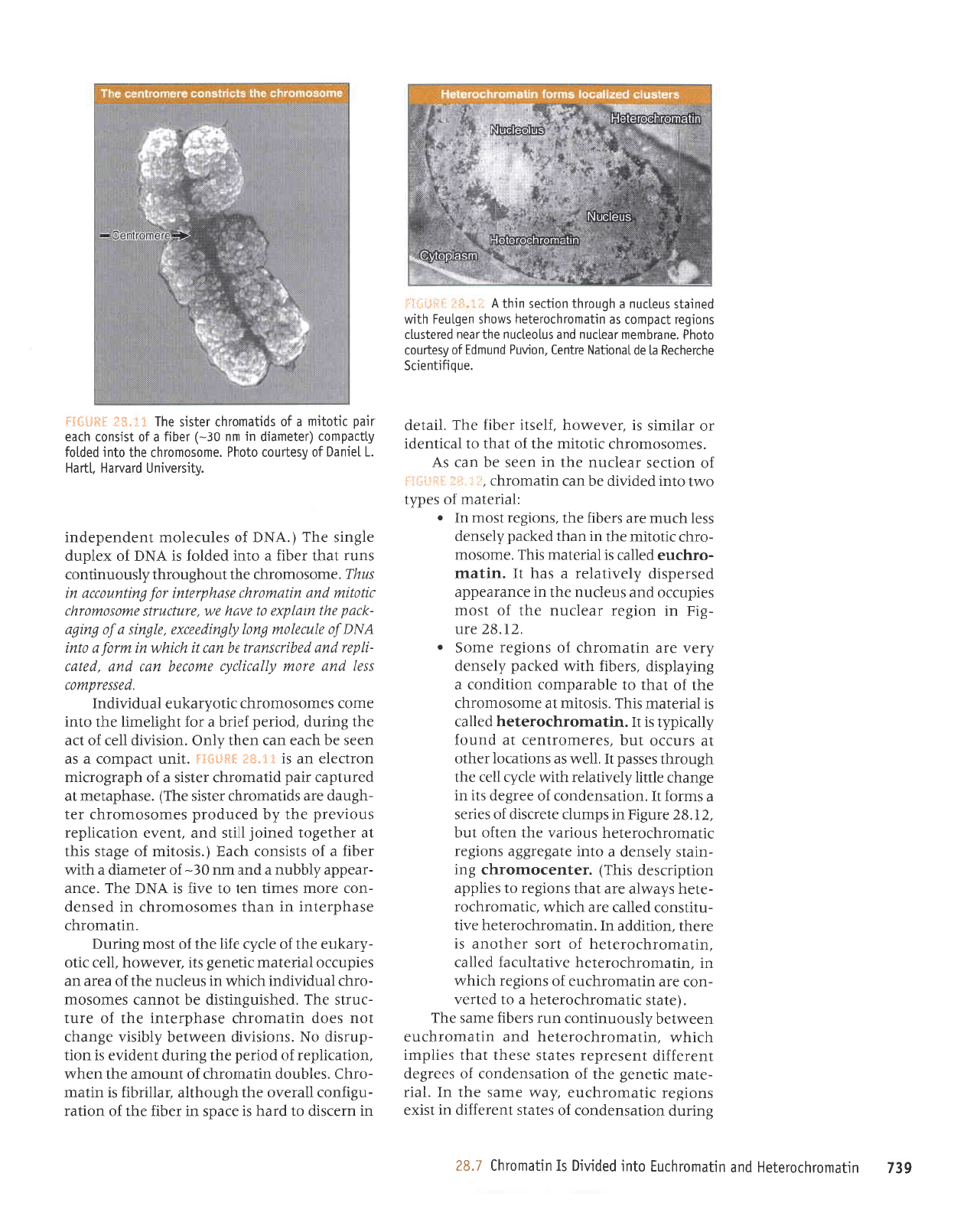
6EL
ur.]PruolqloralaH
pue
uqpuolqlnl
olur
pephr0
sI uqeuolql
/.gz
Surrnp
uorlesuJpuoJ
Jo
salpls
lueJaJJrp
ur
lsrxe
suor8ar
JllptuoJq)na
'trett
erups eql uI
'lerJ
-eleru
)rleua8 aqr yo
uorlesuapuor
;o
saar8ap
tuJJeJJrp
tuasardar
sJtpts
esJr{t
teqt
sarldur
q)IqM'ullPruoJqJoJelJq
pue
ullprxoJr{JnJ
uaaanlaq
dlsnonurluoJ
unJ sJJqrJ Jtlrps JqJ
'(atels
)rlpruoJqJoJJtJq
p
ol
pJuel
-uoJ
JJe
ullpruorqJna;o
suor8ar
qllq,tt
ur'urteruoJqJorelJq
e^rlplln)pJ
palle)
'ullPruoJqJoJeleq
Jo
lJos
Jerlloue sr
eJeql'uolllppe
uI'uueuoJqJorJlaq
a^r]
-N]I1SUOf,
PJIIE]
AJE
qJIqM
'JIIEIUOJqJOJ
-a1aq
sLe.,vrp are
teql
suor8ar ol
sJIIddp
uorldrnsap
srql)'raluaJoruorqJ
8ur
-ure1s
zllasuap
e otul
arc8ata9e suor8ar
JrlPruoJqf,oJelJq
snorJp^ eqt
ua4o
lnq
'(.I'ge
arn8rg
ur sdrunlr
JleDSrp
Jo
sarJes
e sruJoJ
U
'uorlesuJpuo)
Jo
aar8ap s1r ur
aSueqr Jptrl ^le^nelJr qtrm
apl:1ar aql
q8norql
sassed
tI
'llam
se suorteJol raqto
le
srnJJo
lnq
'seJaruorluJl
le
punoJ
L11errdl1
sl
tI'ulleurorqJoralaq
pelle)
sI
IerralPru
srqJ
'srsolrru
lp
elllosoruoJrlJ
Jql
Jo
leqt
ol alqeredruor
uortrpuof,
p
Surz(eldsrp
'sreqrl
qryvr paped
.dlasuap
z(ra,L
are ulleruoJqJ
;o
suor8ar aruog .
'z
I'82
rrn
-3lg
ul uor8a:
JeJIlnu
aql
Jo
tsoru
sardnrro
pue
snJIJnu
aql ur aruereadde
pasradsrp
,(1a,Lr1e1ar
e
seq
tI
.ulleru
-orqJne
pJIIeJ
sr
lerJelelu
srqJ'Jruosou
-oJqf,
Jrtotru
aql ur ueqt
pa>ped
Llasuap
ssal
qJnru
aJp
sJaqrJ aql
'suor8ar
lsour
ul o
:lerJateur yo sadLl
o1vtl 01ul
pJpl^p
aq ueJ urtpluorql
',il
;
i"ri"
.,irii:*]...1
JO
UOI])JS
JPJIJNU
Jql UI UEJS Jq UEf, SV
'saruosoruoJqJ
Jr1ol[u aql
]o
lpqr
o1
lpJrluJpr
Jo Jelrurrs
sr ?a^J^roq
'JIJSlr
JaqrJ aqJ
'lrptJp
'anDgrluat]s
oqllaqlou
pl
op
lpuoqpN
arlual
'uohnd
punurpl;o
fsalnor
oloqd
'euerquau
realJnu
puP
snloallnu aql.rPau
pelalsnlr
suorbet
lreduol
se urlpurorLlloreleq smoqs ua61ne1
qlrm
paurels
snollnu e
qbnorql
uorllos urLll
V
i: ij"r
l,:f ilril:i
ur urJ)srp 01
pJeq
sr JJPos ur JeqrJ aql
Jo
uorleJ
-n8quor
ilpralo
aqr
qEnoqfle
tplluqrJ sr urteur
-oJq)
'selqnop
uuPruoJq)
Jo
lunoruP
aql ueqM
'uolterqdar;o
porrad
eql Suunp
lueprlJ
sr uop
-dnrsrp
oN
'suorsrlrp
ueamleq,{1qrsn a8ueqr
lou
seop
ulteuorqJ aseqd;a1ut ar{l
Jo
Jrnl
-)nJls
JqJ
'paqsrn8urlslp
aq
louupr
saruosour
-oJql
pnpr^lpul q)rr{/!t
ur snJIJnu Jql
Jo
eaJe
ue
sardnrro
lerJalerrr
Jrlaua8 slr tJlJllt.oq
'llJJ
)r1o
-^dre>1na
eq1
Jo
alJ^l elrl aqt
Io
tsoru
Suunq
'urleIuorqJ
aseqdralur ur upql saruosoruoJql ur
pJSuep
-uo)
aJoru sJrurl uJl 01 sArJ sl
vN(
JqJ
'JJup
-readde.,(1qqnu
e
pue
uru
0€-
Jo
rJlaruerp e
qllm
JeqrJ e
Jo
slsrsuor
qreg
('srsolnu
yo
a8els srql
te
raqtaSol
paurof
IIIIs
pup
'luela
uollerqdar
snornard aqt
dq
pa;npord
seurosoruoJqJ Jat
-q8nep
are sprlpruoJqJ Jalsrs aq1)
'aseqdetau
lp
pa:n1der
rrcd
prleruorqJ
relsrs e
1o
qderSonnu
uoJtJJIa ue sr
T
t-*f
*$dril1.{
'l1un
nedruof,
e sp
uaas
eq
qJpJ
ueJ uaqt
,{1ug
'uorsr^rp
IIJ) Jo
De
aqt Surrnp
'porrad
Jerrq
e ro;
tq8lauq
aql olur
Jr.uo) sJruosoruoJqJ
:rtoz{re4na
I
en
prArpul
'passalaw0)
ssal
pur2
atow
fiTacqth
awonq uw
pua
'patra)
-11dat
pua paqtnsuuti
aq uw
il
tplt4lvt ul wol o olut
VN7
to
aru)apw 6uo1 [16uryaatxa
'aPuts
o
to
6ut6u
-4cad
a4l ula1dxa
q
a^all a/w'alnpn4s
autlsualJ4)
)!101!w
puo
wlalulJtp
asoqdtalut tot 6u4unona ut
snLlJ'
JufosoruoJq) aql
tnoqSnorql,{lsnonuquor
sunr
tpql
JeqrJ
e otur
pJploJ
sl
VN11
;o
xaldnp
a13urs eqI
('yNC
Jo
salnlJloru
luapuadapur
'Alr.sro^rufl
pre^.lPH'llPH
'-l
lorupq;o
r\salnor
oloqd
'aurosourolql
aql olur
poploJ
{11reduor
Qalauerp
ur Luu
gg-)
laq!J
p
Jo
lslsuol
qrpa
.lrpo rrlolrul
e
Jo
sprlPulolql ralsrs aLlI
Et'*i1
ltj{ll}Hj
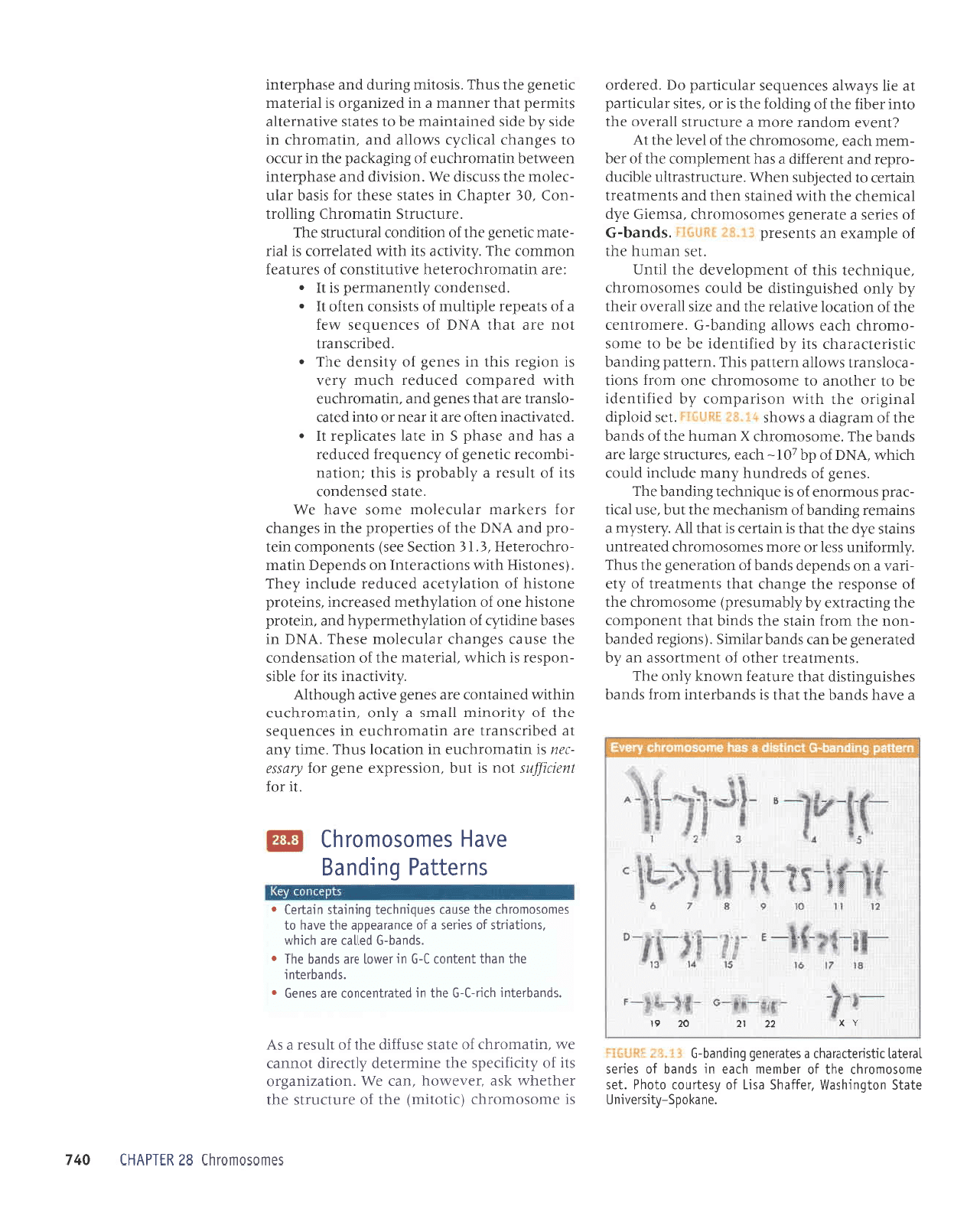
'ou
Pl ods-^lrslaAru
n
elPls uol6urqsPM
'relJPqs
esrl
Jo
Asallnol
oloqd
'las
eui0s0ur0rLll eql
J0
laquroul
qrPa
ur spueq
Jo
sauas
lPlelel
lrlsuallPreql e salplauab
6urpueq-!
:,
,
e s^eq spuPq Jql
lPq]
sr spupqJelur uorJ spueq
sJqsrnBuusrp
tpqt
aJnteaJ uuou>l .{1uo aq1
'sluJrulpeJl
JJr{lo
Jo
luarulrosse
ue
{q
paleraua8
aq up)
spueq Jelrur5
'(suor8ar
pepueq
-uou
Jqt ruoJJ urels aqt
spurq
teql luJuodruoJ
eql 8up)enxa Lq dlqeurnsard)
auosoruoJqJ aql
Jo
esuodsal aqt a8ueqt
tpql
sluJrutpart
;o
L1a
-rrpn
p
uo spuadap
spueq
Jo
uorleraua8
Jqt snqJ
'l.puroyun
ssJI Jo arotx sJrlrosorlroJqJ
pelpaJlun
surels a.dp eqt
tpqt
sr
ureuJJ sr
teql
ilV
'LralsLru
e
sureruJJ Surpueq;o
rusrueqJJru Jqt
lnq
'asn
lp)rl
-rerd
snoru.roua
Jo
sr
anbruqrat Surpueq
aq1
'saua8
Jo
sparpunq
Lueu apnpur
plnoJ
qllqm
'VN11
Jo
dq
z0I-
qrpe
'srrnlJnls
e8rpl arp
spueq JqJ
'aurosoruoJq)
x
upunq Jqt
Jo
spupq
aqt;o ruer8erp P sMoqs
'1as
proldrp
leur8uo
eqt
qtlM
uosrredruor Lq
par;rluapr
aq
()1
Jeqloue
()1
JurosoruoJq) Juo
ruoJJ suorl
-e)olsueJl
smollp uraled
srql
'ura11ed
Surpueq
f,rlsrJalJpJeqr s1r Lq
perJrtuJpr
Jq
aq ot eruos
-ouorqJ
r{JeJ
s.,ra.olle
Surpueq-5
'JJJuroltuJJ
Jql
Jo
uollP)ol J^I1PIeI
3q1
puP
JZIS
IIerJAo
rr3ql
.dq Aluo
paqsrn8ultsrp
Jq
plno)
sJruosourorq)
'anbruqral
srq]
Jo
tuarudola.tap
aql
Irtun
;o
aldruexa
ue sluasard
'lJs
Lrerunq aql
'spueq-!)
Jo
sJlres e ale.raua8
seurosourorqr
'esruarg
aAp
IPf,ruJqJ
eql
qlrM
peurpls
uJql
pup
slueurleJrl
uleuJr
ot
papalqns
uaqM'JrnDnr]sertln
alqDnp
-ordar
pue
luaJJJJrp
p
seq
tuJtuJlduror
aqt
yo
raq
-uJru
qJeJ
'JruosotrroJqJ
aql
Jo IJ^JI
Jql
lV
zlue^e
uropuer
aJour
p
JJnlJnrls
IIeJa^o
aql
olur JaqrJ
Jqt
Jo
SuploJ
Jqt sr Jo
'selrs
relnrrtred
1e
aq sde,trle
satuanbas
relnrrlred oe
'pJJJpJo
sauosorxolql
8z
ulldvHl
sr eruosourorqr
(ltolrur)
aql
yo
aJn]f,nJts eql
rJqlJqM >lse
'Ja^s^^oq 'uPJ
JM
'uollezlueSJo
s1r;o dtor;nads aql JunuJatep
[lDartp
touueJ
JM
'urleruoJqJ
Io
31e1s JSnJJrp
Jql
Jo
llnsal
e sv
'spuPqralur
qrp-l-!
aql ur
palPrluoruol
are
sou0!
r
'spueqlalu
r
aql ueql
lualuol
l-!
ut ieMol
elP spueQ aLl-[
o
'spuPq-9
pallel
erP
qrtqM
'suorlpuls
Jo
sauas e
1o
aruereaddp
eql alpq ol
sauosouorql aql asnp) sanbruq:a1
6utuLels utplal
r
aAPH sauosoru0Jql
'11
roJ
Tuan{lns lou
sr
tnq
'uorssardxa
aua? rc1 fuassa
-Jar./
sr urleurorqJnJ ur uorlPJol snql
'arur1
.{.ue
le
paqlJlsuerl
eJe ullpuroJqJnJ ut
saruanbas
Jql
Io
,(ltrouttu
llelrls
e
.dluo
'urlBruorqf,nJ
urqtrM
pJureluoJ
are saua8 anrpe
q8noqrly
'Alr^rlJPur
slr JoJ alqrs
-uodseJ
sr
qJrqM
'lErJslPru
Jql
Jo
uorlesuJpuoJ
Jqt JSneJ sa8ueqr reln)Jloru
JSeqJ
'VNO
ul
saseq auprtl:
yo
uone1.{qlaruradLq
pue
'uralord
Juolsrq Juo
Jo
uor1e1,{qtaru
peseaJJur
'sutalord
Juolsrq
;o
uorle1.ri.1aJe
pJJnpaJ
apnpur ,i.aq1
'(sauolsrg
qllm
suorpeJJtul uo spuadaq ulteru
-oJqJoJJlJH
'€'I
€
uorlJJS aas) sluauodruof ural
-ord
pue
VNe
Jqt;o saruadord
aqt ur sa8ueqr
roJ
sJa>lJeru reln)elou auos JAeq J^A
'alels
pJSuapuoJ
str
Jo
tlnseJ
e
Llqeqord
sr srqt
luorteu
-rqurof,JJ
rrlaua8
Io
.,{.ruanbarJ
pJJnpeJ
e seq
pue
aseqd
5
ur Jtpl salerrldar
1y
.
'p3lP^rDeur
uJuo eJP
1r
JeJu Jo olur
palPJ
-olsuPJl
3Je
]pq]
sauaS
pue
'urleruoJqJns
qlr,r,r paredruoJ peJnpar qrnru
.drarr
sr uor8ar srqt ur saua8
yo ,{lrsuap
aeJ .
'pJqrJ)sueJl
tou
JJe
leqt
VN11
;o
saruanbas
,raa;
e;o sleadar aldrtlnru
Jo
stsrsuoJ uJllo
]l
r
'pJSuJpuof,
,(lluauerurad sr
lI
.
:eJe
urleuro-It{]oralJq J^rlnlrlsuoJ
Jo
saJnleaJ
uoruruoJ aq1
'L1r,l,r1re
sll
qtIM patplJJJoJ
sr
IprJ
-Jleur
f,IlJuaS aqt
1o
uolllpuof,
IeJnpnJls
JqJ
'
JJnlJnJtS ullPurorq)
3ur110r1
-uo:)
'0€
rardeq3 ur satpts esJql JoJ srspq Jeln
-JJIour
Jql ssnrsrp JM'uorsrlrp
pue
aseqd,ralur
uJaMlJq urleluorqf nJ;o Sur8eped Jql ur rnJJo
ot sa8ueqr
lelpLr
smolle
pue
'urteruorqJ
ur
aprs Lq
eprs
peurptureur
aq ol selets alrteuratlp
slturad
leql
rauueu e ur
pazrue8ro
sr
Iprrelpru
rrtaua8 aqt snqJ'srsotru Surrnp
pue
aseqdratur
O'L
rx
ee tu
Qz
6r
sutailPd
6urpueg
